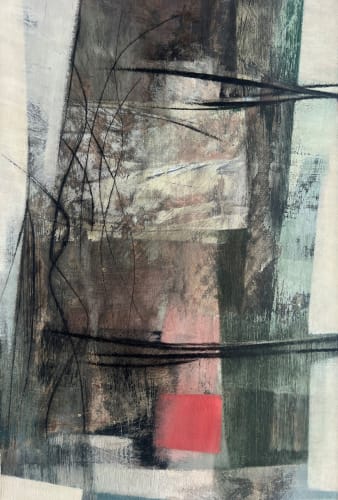Alexander MacKenzie 1923-2002
-
 Alexander MacKenzieRed Serpentine, 1961Oil on panel49 x 23.5cm (19 x 9 ins.)
Alexander MacKenzieRed Serpentine, 1961Oil on panel49 x 23.5cm (19 x 9 ins.)
Framed: 66cm x 39.7cm (26 x 15.6 ins.)View full details
Alexander MacKenzie has been accurately characterised as ‘a powerful and distinctive member of the post-war generation of Modernists at St Ives when the art colony was a hot-bed of new talent.’ His scraped surfaces and the technique of overlaying a mixture of translucent layers of paint juxtaposed with more opaque areas, recalls the work of Naum Gabo and later Ben Nicholson and John Wells.
Alexander Mackenzie was born on 9 April 1923 in Liverpool and lived in Yorkshire from 1932 to 1941. He married Coralie Crockett and the couple had three daughters; Pat, Althea and Rachel.
At the beginning of the war his school was evacuated to Newburgh Priory, where he had his introduction to art. He later described the Priory as "a marvellous place, filled with tapestries and paintings”.
As soon as he was old enough, MacKenzie enlisted in the army, serving for 5 years in the armoured Inns of Court Regiment, part of the 11th Armoured Brigade. He commanded an armoured car during the D-Day offensive that raced across France, Holland and into Germany. In 1945, aged 23, MacKenzie was de-mobed and went to study at Liverpool College of Art.
In 1951, following his graduation from the College of Art, the young artist accepted a teaching post at Luskudjak School in Cornwall. In Cornwall he soon established close friendships with many artists including Ben Nicholson, Barbara Hepworth and John Wells becoming one of the St. Ives group of artists and a member of the Penwith Society of Arts in 1952 and the Newlyn Society of Arts in 1956.
MacKenzie, along with Denis Mitchell and Michael Snow, was the author in 1961 of a letter to the Penwith Society that led to Barbara Hepworth’s resignation from its hanging committee and briefly from the Society. MacKenzie and his young cohorts complained about the Society’s domination by ‘a small group of influential members … quite unwilling to relinquish power and let younger people share control.” They went on to say, quite pointedly in respect of the Nicholsons, “It would surely have been more sensible for not more than one member of a family to seek office at the same time.”
In 1964 MacKenzie was invited to become a senior lecturer at Plymouth College of Art. He stayed there for 20 years until 1984, becoming the Head of Fine Art.
MacKenzie started to exhibit at the Waddington Galleries in London in 1957. There he had successful one-man exhibitions in 1959, 1961 and 1963. In 1960, he took part in the 21st Watercolour Biennale in New York and, in 1962, he exhibited at the Premio Marzotto exhibition in Rome. The prestigious Durlacher Galleries represented MacKenzie in New York with two one-man exhibitions in 1960 and 1962. (Durlacher also represented Ben Nicholson, Barbara Hepworth and John Wells. Other St Ives artists showed at much smaller New York galleries: Peter Lanyon at Catherine Viviano and Patrick Heron & Terry Frost at Bertha Schaefer).
MacKenzie had major one-man retrospective exhibitions at the Plymouth City Art Gallery in 1965 and at the Newlyn Art Gallery in 1980. Further one-man exhibitions were held at the Newlyn Art Gallery in 1985, the Festival Gallery Bath in 1982, three shows at Malzahn Gallery in London who represented MacKenzie from the late 1960s, and at Austin/Desmond Fine Art in London in 1999 and 2007. He was also included in many group exhibitions around the world, including at the Whitechapel Art Gallery in 1959, 21st Watercolour Biennial, Brooklyn Museum, New York in 1969, Premio Marzotto International Exhibition, Rome in 1962, the major retrospective St Ives 1939 – 1964 at the Tate Gallery in 1985 and Saint Ives, Montpelier Sandelson in 1995.
In 1986 he moved to Penzance where he lived and worked for the rest of his life.
Mackenzie’s work is included in many world renowned public collections including the Tate Gallery London, the Arts Council, the Contemporary Arts Society, the Art Gallery of New South Wales, York City Art Gallery, Plymouth City Art Gallery, and the Gulbenkian Foundation.
Within David Bowie’s wonderful modern art collection, which encompassed works by many leading St Ives artists (Peter Lanyon, Paul Feiler, Terry Frost, Denis Mitchell, Bryan Wynter, Wilhelmena Barnes-Graham), one of the most extensive collections were the 11 paintings by MacKenzie.
Alexander MacKenzie died on 18th September 2002. Although not a prolific artist, as his quality control was strict and if he was not completely satisfied with an artwork’s outcome he scrapped it, he has been accurately characterised as ‘a powerful and distinctive member of the post-war generation of Modernists at St Ives when the art colony was a hot-bed of new talent.’ He painted relatively slowly, usually on gesso coated boards or panels (as with Red Serpentine) so that he could scratch back and over-paint the surface repeatedly. Scraped surfaces and the technique of overlaying a mixture of translucent layers of paint juxtaposed with more opaque areas, recalls the work of Naum Gabo and later Ben Nicholson and John Wells. Wells was a particular influence for MacKenzie. Effectively these techniques came to represent a St Ives school style that as the author Chris Stephens expresses, “could conjure the sublime and delicacy of nature’s natural progress".


